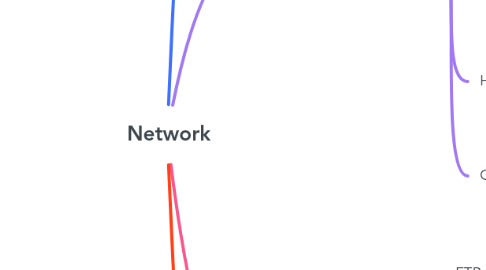
1. Types
1.1. LAN
1.1.1. A local area network is a network that connects devices in a small geographic area like an office or a building.
1.2. WAN
1.2.1. A wide area network is a network that connects devices over a larger geographic area like cities, countries, or continents.
1.3. WLAN
1.3.1. A wireless local area network is a network that uses wireless signals instead of cables to connect devices in a small geographic area.
1.4. MAN
1.4.1. A metropolitan area network is a network that connects devices in a metropolitan area like a city or a town.
1.5. Internet
1.5.1. The internet is a global network of networks that connects billions of devices and allows people to share information and communicate.
1.6. Intranet
1.6.1. An intranet is a private network that is used within an organization to share information and resources.
2. Network Components
2.1. Router
2.1.1. A router is a network device that forwards data packets between computer networks.
2.2. NIC
2.2.1. A network interface card is a hardware component that connects a computer to a network.
2.3. Modem
2.3.1. A modem is a device that converts digital signals to analog signals and vice versa.
2.4. Switch
2.4.1. A network switch is a device that connects devices in a local area network and forwards data packets between them.
2.5. Hub
2.5.1. A network hub is a device that connects devices in a local area network and forwards data packets between them.
2.6. Cables
2.6.1. Cables are physical media used to connect devices in a computer network.
3. Network Protocols
3.1. FTP
3.1.1. File Transfer Protocol is a network protocol used to transfer files between computers on a network.
3.2. TCP/IP
3.2.1. Transmission Control Protocol/Internet Protocol is a suite of communication protocols used for connecting devices on the internet.
3.3. HTTP
3.3.1. Hypertext Transfer Protocol is a network protocol used to transmit and receive data over the World Wide Web.
3.4. HTTPS
3.4.1. Hypertext Transfer Protocol Secure is a secure version of HTTP.
4. Network security
4.1. Methods of securing
4.1.1. Encryption
4.1.1.1. The process of converting plain text into a code to prevent unauthorized access to sensitive information.
4.1.2. Firewall
4.1.2.1. A security device that monitors and controls incoming and outgoing network traffic.
4.1.3. Access Control
4.1.3.1. The process of managing and restricting access to a network
4.2. Risks and threats
4.2.1. Hacking
4.2.1.1. Unauthorized access to a network or computer system with malicious intent.
4.2.2. Virus
4.2.2.1. A type of malicious software that replicates itself and spreads to other computers.
4.2.3. Malware
4.2.3.1. Malicious software that is designed to cause harm to a computer system, network, or device.
4.2.4. Phishing
4.2.4.1. A form of online fraud where attackers trick individuals into providing sensitive information.
